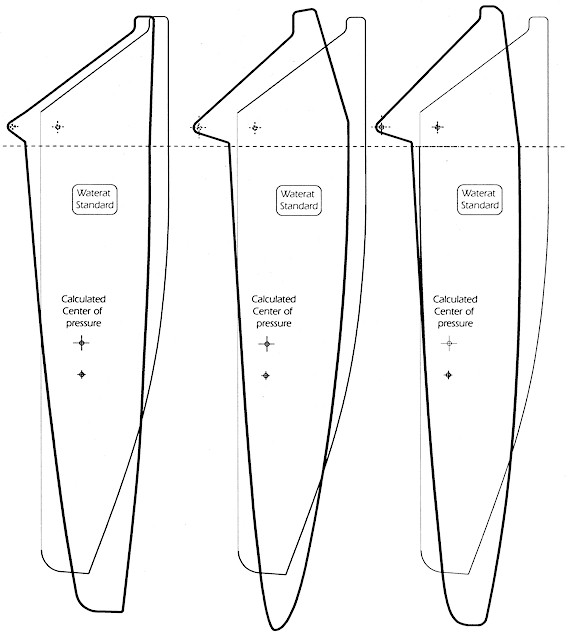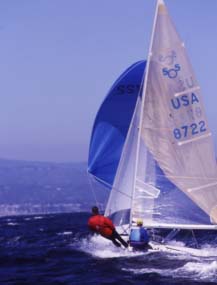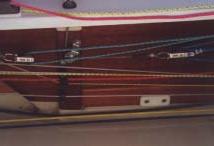LONG BOARD Revolution |
|
The 505 has changed a lot in two decades. Sails have gone high-tech. Launchers dominate where bag boats once ruled. Hull construction is stronger and more durable. Yet one vital part of the 505 has been curiously overlooked. Since the late 1970s, the shape of the 505 centerboard has remained virtually unchanged. Until now.
505 foils are undergoing a long overdue rethinking. The focus is the long and narrow high-aspect centerboard. So far, the performance of the boards has been impressive. Seven of the top ten boats at this year's windy North Americans in Santa Cruz sailed with the Waterat-built boards. And the apparent success of the new board has touched off an important debate about the benefits of going high aspect.
To be sure, the boards, and their companion high-aspect rudder, have yet to make it into the mainstream.They are still only being used by the go-fast California teams and a few East Coasters such as myself. The standard foils are winning regattas and no blade can transform a mid-fleet sailor into a world champion. But one thing seems clear. The sheer dominance of the boards at the North Americans raised the question of whether a championship program can succeed without it. There are still plenty of doubters out there. But consider this: The ultra-competitive teams who have gone high aspect show no sign of turning back.
EVOLUTION
By my reckoning, the idea for the new board started at the 1995 worlds in Cornwall, England. Howard Hamlin and I both heard Krister Bergstrom, the four time world champion, observe that no one was paying attention to centerboard design. I didn't realize it then, but Hamlin and I both concluded the same thing: Bergstrom was right.
After Cornwall, I talked to Larry Tuttle at Waterat. The 505 board design had remained virtually unchanged since 1979, and he agreed it was probably time to rethink it. He immediately focused his attention on a higher aspect centerboard. Until then, Tuttle had little incentive to develop new foils. The old foils were working well and without someone to invest the money in foil development it made little sense to proceed.
While the 505 design had remained stagnant all those years, foil designers for other boats had increasingly turned to higher aspect blades. Their conclusion: A long board with a short chord generated more lift and less drag. In 1992, the ratio of length to chord for an America's Cup boat was 12 to 1. Waterat had followed the trend with its high-aspect sailboard fins and foils for other boats.
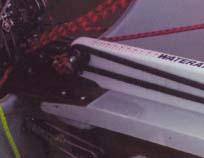 |
Two boards:
|
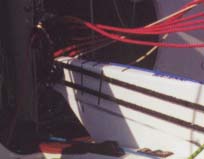 |
5o5 centerboard evolution |
But there was a major hurdle to clear. Tuttle couldn't simply build a bigger board and put it in the trunk. Sure, class rules provide that the centerboard can be of any shape. But the rules also state that the board must fit in the trunk, and that the aft end of the trunk be no closer than 1200 mm from the transom. The problem for Tuttle was how to find a way to fit a blade that measured in at about 55 inches into 50 inch space. And to add to the challenge, he had to do so without affecting the balance of the boat: He couldn't just move the board forward without the boat developing excessive weather helm.
By the summer of 1996, Tuttle had achieved a breakthrough. He designed bracket on the front of the centerboard, just forward of the standard centerboard bolt hole. When you see it, you are not impressed with its complexity. But in the forty year history of the class no one else had thought of it. This bracket allowed the board to hang from bolt more than 5 inches forward of the standard fitting. In the simplest terms, it allowed a board 55 inches long to fit in a 50 inch space. And most importantly, it did not affect the balance of the boat: The design of the bracket allowed the long board to be extended in the water in the same location as the standard Waterat foil.
With the major breakthrough achieved, Tuttle wanted long and narrow board to create maximum lift and minimum drag. The area of the first long board was the same as the standard foil and 4.75 inches longer. By going to the maximum length, there was the risk of generating too much power. But in this first version, the only attempt to depower the board was to make it more flexible, much like our bendy masts.
SPEED TRIALS
Waterat shipped its first high aspect centerboard in June 1997. Tuttle sent me the mahogany pads and the necessary instructions to make a new bolt hole. The board fit, it jibed, and the boat was balanced. Mike Mills and I took it to the Denmark Worlds with some apprehension about its performance in the breeze. Although we did not sail the boat well in light to moderate conditions, we were faster in straight line than boats that I could not beat before. We also learned that the board was sensitive to rake in moderate conditions. In moderate conditions with chop, we did not have an advantage.
We had no windy races. I reported to Tuttle that in light air the board was significant improvement. I knew that well-prepared team using my board in Denmark would have won. At the time, I thought that every American would have the foils for the Hyannis Worlds. I was wrong with two exceptions. Mike Martin/ Howard Hamlin and Scott Ikle/Tyler Moore also started sailing with them. Then came the second chapter in the evolution of the foils. Tuttle and Mike Martin began to work on further refinements. After extensive consultations, Martin designed a set of foils for his program. Martin's design incorporated the pin bracket to create a higher aspect foil, but he wanted foils that he thought were better suited for the breeze. So he designed a board that was smaller overall and had less area at the tip.
Martin and Hamlin used a version of the new foils at the Hyannis Worlds. Although they were prepared and fast, they finished second to Nick Trotman and Mike Mills. The difference was probably more technique than equipment. But people began to notice the new foils, and Martin and Hamlin deserve credit for that. The evolution of the board accelerated after Hyannis, and the results were obvious at the worlds the following year in France. The high-aspect boards, refined after Hyannis, placed first, second and third at the regatta.
|
|
I did not know it at the time, but Martin and Hamlin were figuring out that they could sail with the board raked further forward in more breeze than Tuttle had thought. We had a tuning session in June in Falmouth, Mass., where Peter Alarie coached us. We did a lot of sailing in about 18 knots and Alarie urged us to sail with the board raked forward. We did and it worked. Several weeks later in Kingston, we had similar wind and had similar results. I privately noted that after sailing a handful of regattas with the new foils, Alarie, initially a doubter, had become convinced that the new foils were far superior to the standard foils. Lars Guck, Alarie's boat-building partner, has produced two high-aspect boards.
Hamlin and Martin also changed their technique in light air and started sailing with some heel and weather helm. Alarie thinks that technique works because the boat is easier to steer with some weather helm. I think it works because the rudder works as a lifting surface when it is loaded up.
505 centerboard pivot
The centerboardpin is further forward for the high-aspect board.
The high-aspect pin is 8'10.5" from the transom. The standard is 8'4".
Waterat Sailing Equipment
As a general rule, the board is more difficult to tune, requires more practice to master and is less forgiving. That means the more time you put in the greater benefit you'll receive. With the crew on the wire, for example, the boat is more sensitive to board position. One inch of board movement is more significant than on the standard versions.The current state of knowledge seems to be as follows:
Light to moderate air: board raked all the way forward; intentionally develop weather helm to load up the rudder.
Full power or slightly overpowered: consider bringing board up to vertical position.
There seems to be a disagreement about over-powered conditions. I understood Martin and Hamlin at the Santa Cruz North Americans debriefings to say that they rarely, if ever, raked the board back past vertical. They argue that the board should jibe in all wind conditions. Tuttle believes that in over-powered conditions you should continue raking the board until you prove it is raked too much. I know one thing. I sail with Mike Welch who is about 6 feet 2 inches and 200 pounds. In twenty-five knots, John Fry/Robin Brown, Andy Zinn/Danny Thompson and Steve Bourdow/Mike Martin are faster. Those crews have significantly more leverage than Welch. For the time being, if we cannot match their speed in 25 knots, we are going to rake the board more even if the board stops jibing.
It seems clear that more design refinements are in store. One idea is to make the boards narrower and create larger rudders to work as a lifting surface in tandem with the boards. Another idea is to make the boards twist and flex more so they can depower in the breeze. Whatever course the new boards take, they seem to have permanently altered the 505 speed equation.
 |
 |
 |
This info as: PDF Document |
Take a ride onboard a 5O5; Sailing at its
purest...
20+ knots of breeze + 1 HeadCam GoPro on the crew trapping on a 5O5.
TANK TALK - FALL 2000
